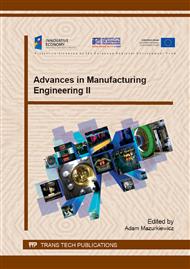p.61
p.71
p.77
p.83
p.89
p.95
p.101
p.107
p.112
Simulation Model of Surface Heterogeneity, Using Gielis' Superformula for Adaptive Methods of Image Analysis
Abstract:
The article presents a developed orginal model designed to increase the efficiency of the processes of the design of adaptive image analysis methods used for detection of surface defects in materials. The model was created as part of activities related to the Strategic Program – Specialized knowledge bases and expert systems for the simulation of complex processes. The methods presented in this paper make it possible to accelerate design process, including testing of algorithms developed for a wide range of surface defects, such as: cracks, discoloration, loss of materials, geometric distortion, or even the presence of defect agglomerations caused by corrosion, without the need for the acquisition of the physical image of the actual objects. This in many cases can be a significant problem for engineers who design automatic optical inspection systems, because the acquisition of test objects with specified defects which are characterized by a fixed range of values of selected parameters is not always possible. This paper presents a formal model designed to generate material defects on the surface of three-dimensional virtual objects, which is equivalent to the acquisition of actual data from vision systems. The model takes into account various surface characteristics such as their texture or roughness by using mapping by the Blinn method. The results of the use of the system developed for the classification of products represented in digital images for which image analysis algorithms have been based on so-called artificial intelligence in the form of dedicated neural networks are presented. As described in this paper, artificial neural networks are an example of adaptive models, and provide the ability to solve problems for which there are no deterministic models. The models, however, require the use of learning processes (training) with the use of extensive data sets, which in this case were generated with the use of the developed solution model.
Info:
Periodical:
Pages:
89-94
Citation:
Online since:
August 2015
Authors:
Price:
Сopyright:
© 2015 Trans Tech Publications Ltd. All Rights Reserved
Share:
Citation:


